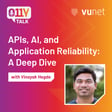
Episode 6: Crafting Resilient Products - A Closer Look with Sarika Atri
We explore the rapidly changing world of modern application development and the critical role observability plays in navigating its complexities. Our guest, Sarika Atri, a seasoned tech leader with experience spanning across Google, Flipkart, and Hotstar, takes us through her fascinating journey from building monolithic applications to leading in microservices, cloud, and serverless architectures.
Sarika shares key insights into the challenges of managing deployments in a CI/CD environment, balancing speed with quality, and the evolution from traditional APM to advanced observability. We also dive into the ongoing 'build vs. buy' debate for observability tools, continuous monitoring best practices, and the essential architectural considerations for scaling observability in large systems.
In this conversation, Sarika offers her perspective on embedding observability from the very start of application development, and the future role of AI in shaping how we monitor and improve complex systems. Tune in for practical takeaways and thoughtful reflections on the future of observability
Also, check out
- Xmplify.tech
- Sarika Atri on LinkedIn













